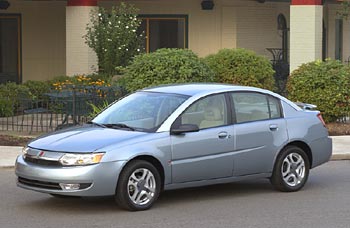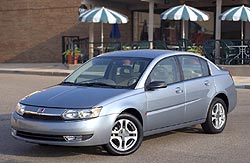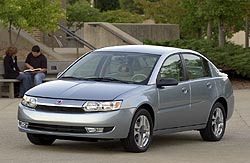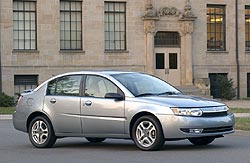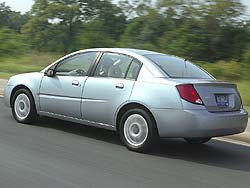by Greg Wilson
A good car, but not a great car
Saturn’s new entry-level car, the 2003 Ion, replaces the enduring SL and SC-series cars which first appeared in 1991 and were updated in 1997. Like its predecessors, the Ion is offered in both sedan and coupe body styles, except the new ‘quad coupe’ has four doors instead of three – there are now two rearward opening door panels instead of just one on the driver’s side.
Both Ion sedan and coupe ride on GM’s new Delta global small car platform which is larger than its forerunner’s, and are equipped with a larger and more powerful 2.2 litre ‘Ecotec’ four cylinder engine, and a new optional 5 speed automatic transmission (sedan) and a new optional continously variable transmission (coupe) (late availability).
Current Saturn owners will be happy to know the Ion has those rust-proof, dent-resistant plastic body panels, and is built in the same plant as the previous model in Spring Hill Tennessee. An interesting new feature on the Ion is customizable roof mouldings which can be ordered in a different colour to match the interior trim. My test car for example, had burgundy exterior paint and grey metallic roof mouldings which matched the instrument panel and door trim.
The Ion competes in the most popular automobile class in Canada, the compact car segment. Competitors for the Ion include the Chevy Cavalier, Pontiac Sunfire, Dodge SX 2.0, Ford Focus, Honda Civic, Toyota Corolla, Nissan Sentra, Mazda Protege, and Suzuki Aerio.
1, 2, 3 trim levels
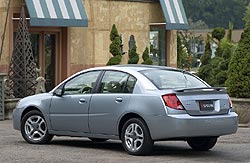 Click image to enlarge |
Ion sedans are offered in three trim levels: Ion 1, Ion 2, Ion 3 – can’t get much simpler than that! Ion 1 models, which start at a reasonable $15,495 plus $900 Freight, include a standard 140 horsepower 2.2 litre four cylinder engine, 5 speed manual transmission, body-coloured bumpers, 14 inch tires and wheels, cloth seats, AM/FM radio with four speakers, 60/40 folding rear seatbacks, electro-hydraulic power steering, tilt steering wheel, digital clock, and driver/passenger front airbags.
I was pleased to see that the base model is available with optional ABS (which includes traction control), and optional head curtain airbags. Many compact cars only offer ABS on higher trim levels, and the Ion is the first compact car to offer optional head airbags.
Ion 2 models, which start at $17,795, add the following standard features to the Ion 1’s equipment list: air conditioning, CD player, 15 inch tires and wheels, body coloured door handles, power door locks, height-adjustable driver’s seat, and better seat fabric.
Top-of-the-line Ion 3 models, with an MSRP of $20,150, add 16 inch tires and alloy wheels, a premium AM/FM/cassette/ CD player with auto tone control, auto reverse music search, and seek and scan functions; power windows, power mirrors, front fog lamps, cruise control, silver-faced gauges, and up-level fabric seats. The Ion 3 is the only model available with optional leather seats.
My test car was an Ion 3 model with cloth upholstery and a five-speed automatic transmission and rear spoiler. With options, Freight and A/C tax, my test car came to $22,850.
Ion is bigger than predecessor
The first thing you’ll notice about the Ion sedan is that it is considerably bigger than the SL-series sedans that it replaces. Length has increased by 168 mm (6.6 in.), width by 20 mm (0.8 in.), and height by a substantial 61 mm (2.4 in.). As well, the wheelbase is longer by 20 mm (0.8 in.). The Ion’s increased dimensions mean more legroom, headroom and trunk space, but most of that extra room seems to have gone into the trunk. The Ion’s roomy trunk (416 litres/14.7 cu. ft.) is about 18% bigger than the trunk of the SL sedan, while interior volume has increased by only 2%.
The Ion is approximately 165 kilograms (360 lb.) heavier than the SL sedan but has a larger, more powerful four cylinder engine to make up for the weight gain. The new 140 horsepower 2.2 litre ‘Ecotec’ DOHC four cylinder engine with counter-rotating balance shafts has replaced both the SL sedan’s base 100 horsepower single overhead cam 1.9 litre four cylinder engine and the SL1/SL2’s 124 horsepower twin cam 1.9 litre four cylinder engine. The new engine is smoother and more responsive but not as fuel efficient, most likely because of the Ion’s extra weight. The Ion’s city/hwy fuel consumption of 9.9 l/100 km (29 mpg)/6.8 l/100 km (42 mpg) is still reasonably thrifty, and surprisingly, fuel consumption with the new five-speed automatic transmission is actually slightly better than with the manual transmission.
The Ion’s suspension is all new, and to some it will be a disappointment. The previous independent rear multi-link suspension has been replaced with a semi-independent torsion beam setup. While the new rear suspension is more space-efficient, and provides a comfortable ride and decent handling over most paved surfaces, it lacks the ability for each rear wheel to act independently. Up front, the Ion retains an independent strut-type setup.
Interior features centre instruments
 Click image to enlarge |
Getting in to the Ion is pretty easy because all four of the Ion’s doors are large, and the roof is fairly tall. However, the rear doors of my test car closed with a loose clunking sound that made me think they weren’t closed properly – even though they were.
Like the Toyota Echo, the Ion has the instruments mounted in the centre dash area at an angle facing the driver. There are two advantages to this: the gauges are not obscured by the steering wheel, and the driver doesn’t have to look down and refocus his/her eyes to see the gauges. But, the driver has to turn his/her head slightly to view the instruments, and drivers do tend to steer where they look…
Though the Ion’s instruments are farther away, I found the white-faced gauges easy to read because the numerals are larger and bolder, and they are back-illuminated at night. The gauges include a large central speedometer, smaller tachometer, and two small fuel and coolant gauges.
As well, positioning the gauges in the centre enabled GM to design a smaller, lower steering wheel which I found easier to hold because it took some of the weight off my arms. As well, the Ion’s steering wheel can be tilted up and down.
Four large air vents, which swivel in their sockets, stick out of the dash – these can be pointed in almost any direction for creative air flow. The dashboard itself resembles a jigsaw puzzle of interlocking pieces of different textures and shades – in my opinion, it doesn’t have the same homogenous look of competitors like the Protege and Civic, and the quality of the plastic materials is not quite as good as some of its import competitors.
The Ion’s front buckets are firm but comfortable, with some side and thigh support, and a medium-quality cloth covering. I liked the ratchet-type height adjustment which allows you to pump down to lower the seat cushion, and pump up to raise it. Each front seat has donut-shaped head restraints, which help improve visibility whether you’re looking from the front to the rear, or vica-versa.
The central instrument control panel is well laid out with plain white lettering on black buttons for the radio/cassette/CD player and heater. Remember, the ‘ION’ logo at the top of the IP is not a cassette player, even though it looks like one. The bottom of the centre stack is where an open storage area is usually found, but not in the Ion. There is an open storage area under the handbrake lever next to a 12 volt powerpoint where you can charge your phone. As well, there is an open coin tray and a flip-down bin to the left of the steering wheel, door pockets, a glovebox, and a small covered armrest/storage bin between the front seats. The armrest though, is too far back to rest your arm on. The Ion has two front cupholders, one larger and deeper than the other; and two rear cupholders.
It might have just been me, but I found my right leg rubbing painfully on the centre console – either the centre console is too wide or the accelerator pedal is too close to the centre console.
The rear bench seat offers generous headroom and kneeroom, but there’s not much footroom under the front seats. I found the raised ‘theatre style’ rear seats comfortable, but the seatbacks were a bit firm. Two adults can sit comfortably at the rear, but three is tight. As well, the centre rear occupant has to straddle the two cupholders which stick out from the back of the centre console. Rear passengers have a 12 volt powerpoint for games and accessories, two rear door pockets, a map pocket on the back of the front passenger seat, and outboard armrests. There are three 3-point seatbelts at the rear, but the two fixed outboard rear head restraints are too small to provide adequate whiplash protection for adults.
The Ion’s 60/40 split folding rear seatbacks can only be released from inside the trunk – a good idea because it prevents thieves from entering the trunk from the passenger compartment. Inside the trunk, there are two cable release handles within easy reach. The trunk lid can be opened with a key or a remote key fob, handy when you don’t want to fumble around looking for the lock or the trunk release. The trunk is big for a small car, and is fully carpeted. Underneath the cargo floor is a compact spare tire and, surprise, the car’s battery. The rear-mounted battery helps balance the car’s front-to-rear weight distribution.
Driving impressions
The Ion’s new 2.2 litre ‘Ecotec’ four cylinder engine idles smoothly and quietly, and acceleration is brisk from a standing start. The engine has generous torque, but 0 to 100 km/h times are about average in the compact car class. According to the Automobile Journalists Association of Canada track tests, the Ion with an automatic transmission goes from 0 to 100 km/h in 11.4 seconds. The engine emits a buzzy sound under acceleration, but is very quiet on the freeway and at moderate engine speeds. At a steady 100 km/h, the engine does just 2200 rpm. At 120 km/h, it does 2600 rpm.
Fuel consumption is thrifty, but not class-leading: with an automatic transmission, the Ion offers 9.9 l/100 km (29 mpg) in the city and 6.8 l/100 km (42 mpg) on the highway. The Ion uses Regular fuel but doesn’t have a locking fuel door or gas cap.
The new 5-speed automatic transmission is exceptional for this class of car. Shifts are smooth and silent, it responds well to kick-down, and it shifts down automatically when descending a grade or braking for a corner. My only complaint is that the shift lever doesn’t have the same tight, well-oiled shift feel as a Civic or Jetta – it just felt a bit loose to me.
The Ion rides very smoothly and tracks well at high speeds, and though it’s not quite as nimble as the SL series sedans, it handles well. The optional 16 inch Firestone Firehawk tires on my test car were quiet on the highway and offered decent grip in dry conditions, but I found they slipped easily when accelerating on wet pavement, something not normally experienced on a front-wheel-drive car.
I liked the Ion’s new variable-ratio electric power steering which is lightweight at low speeds and comparatively quick and responsive when compared with some compact cars. The Ion’s turning diameter of 10.8 m (35.4 ft.) is also comparatively tight. For braking, all Ions have front disc/rear drum brakes with optional anti-lock brakes – four wheel disc brakes are not offered.
Competitor overview
The Ion’s lengthy list of compact competitors includes the best-selling car in Canada, the Honda Civic, and other very popular cars like the Chevy Cavalier, Pontiac Sunfire, Toyota Corolla and Mazda Protege. In most respects – price, horsepower, ride, handling, quietness, cabin space, trunk space, and warranty – the Ion is competitive with these cars, but its level of interior quality and fit and finish was not quite as good as some of the imports, and its conservative styling isn’t really attention-grabbing.
Verdict
The compact Saturn Ion sedan offers a smooth powertrain, a comfortable ride, and a big trunk, but it’s styling and performance aren’t outstanding, and its interior quality could be improved.
Technical Data: 2003 Saturn Ion 3
| Base price (1) | $15,495 |
| Base price (2) | $17,795 |
| Base price (3) | $20,150 |
| Freight | $900 |
| A/C tax | $100 |
| Options | $1,700 (5 spd auto., rear spoiler) |
| Price as tested | $22,850 |
| Type | 4-door, 5 passenger compact sedan |
| Layout | transverse front engine/front-wheel-drive |
| Engine | 2.2 litre 4 cylinder ‘Ecotec’, DOHC, 16 valves, balance shafts |
| Horsepower | 140 hp @ 5800 rpm |
| Torque | 145 lb.-ft. @ 4400 rpm |
| Transmission | 5-speed automatic |
| Tires | Firestone Firehawk P205/55R16 – all season |
| Curb weight | 1255 kg. (2766 lb.) |
| Wheelbase | 2621 mm (103.2 in.) |
| Length | 4686 mm (184.5 in.) |
| Width | 1707 mm ( 67.2 in.) |
| Height | 1458 mm ( 57.4 in.) |
| Trunk volume | 416 litres (14.7 cu. ft.) |
| Fuel consumption | City: 9.9 l/100 km (29 mpg) |
| Hwy: 6.8 l/100 km (42 mpg) | |
| Warranty | 3 yrs/60,000 km |
| Powertrain Warranty | 5 yrs/100,000 km |






